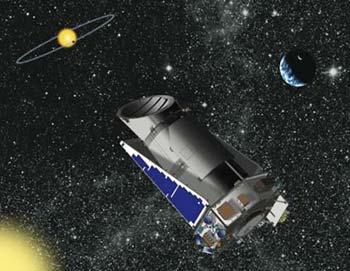Source: Xinhua
03-09-2009 11:03
Special Report: Tech MaxWASHINGTON, March 6 (Xinhua) -- NASA's Kepler space telescope, the world's first mission to hunt for extra solar Earth-like planets, has reached its orbit, NASA said.
 |
| An artist's conception of the Kepler spacecraft. (NASA Photo) |
The space telescope was launched aboard a Delta II rocket on Friday night from Cape Canaveral Air Force Station in Florida.
Sixty-two minutes after launch, the 591-million-U.S.-dollar Kepler separated entirely from its rocket and were in its final Earth-trailing orbit around the sun, an orbit similar to that of NASA's Spitzer Space Telescope.
After the clock ticks down to liftoff, the Delta II's first-stage main engine and six strap-on solid rocket boosters ignited, the NASA TV shows.
Three remaining boosters ignited 65.5 seconds later, and the first-stage main engine continued to burn for 4.5 minutes. The second stage then ignited, carrying Kepler into a circular orbit 115 miles above Earth less than 10 minutes after launch.
After coasting for 43 minutes, the second-stage engine fired again, followed by second-stage shutdown and separation. The third stage then burned for five minutes.
The spacecraft is designed to find Earth-size planets orbiting stars in habitable zones -- regions where water could pool on the surface of the planets. Liquid water is believed to be essential for the formation of life. It will watch a patch of space for 3.5 years or more for signs of Earth-sized planets moving around stars similar to the Sun. The patch that Kepler will watch contains about 100,000 stars like the Sun.
